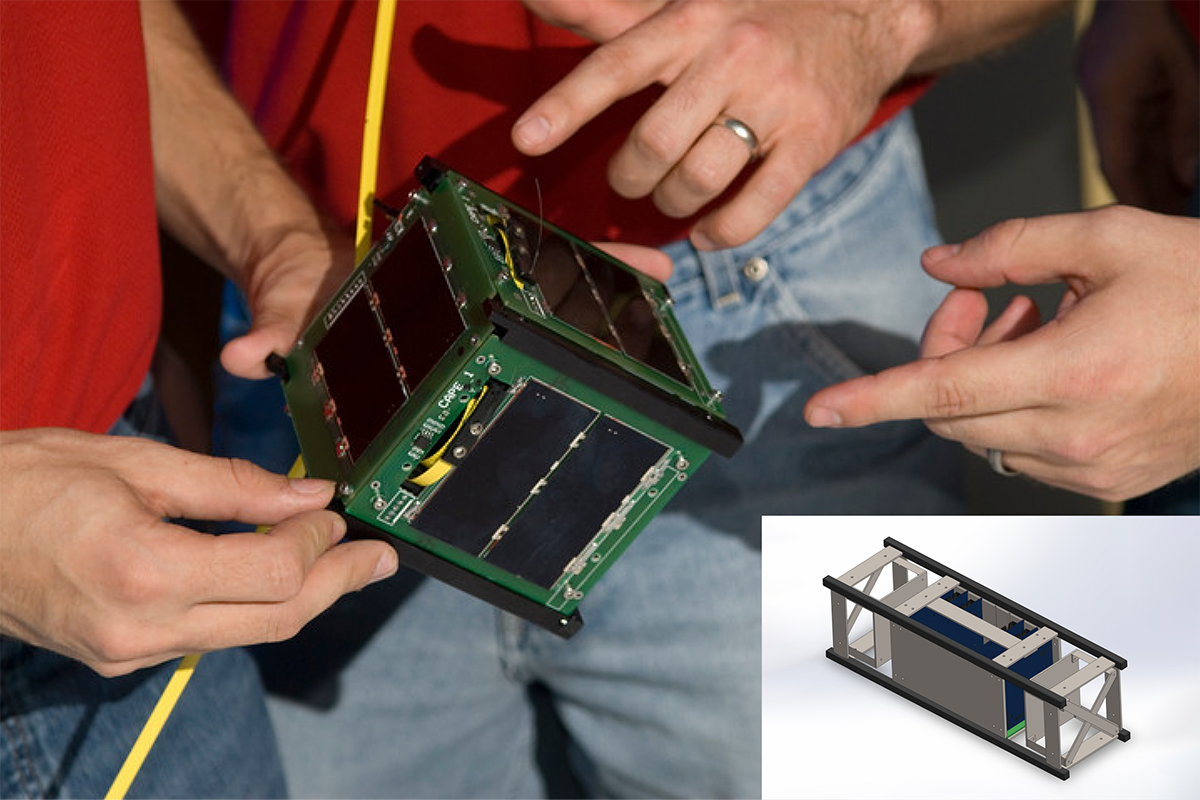A small solar-powered satellite designed and built by University of Louisiana at Lafayette student researchers will measure radiation levels in space to help keep astronauts – and the public – safe.
UL Lafayette’s Cajun Advanced Picosatellite Experience, or CAPE, team will build a small research satellite after being one of eight groups in the country recently selected for NASA’s CubeSat Launch Initiative. The initiative enables colleges and universities to conduct scientific investigations in space; findings, in turn, assist NASA exploration and technology development.
Space is a familiar frontier for the University’s CAPE program, which is coordinated through the College of Engineering’s Department of Electrical and Computer Engineering. With the CAPE-1 satellite in 2007, the University became the first in Louisiana whose students designed, built and launched a working satellite that orbited Earth. CAPE-2 , in 2013, and CAPE-3, in 2021, followed.
CAPE-4 is projected to blast off sometime between 2024 and 2027, NASA’s timeline for its latest round of CubeSat initiative satellites. Once in space, CAPE-4 will be ejected to circle Earth at least once a day – or more – depending on an orbit path that NASA will determine.
During each trip, the satellite will comb the atmosphere for radiation levels, said Dr. Jared Tessier, an instructor in the Department of Electrical and Computer Engineering. Tessier leads the CAPE Satellite Team. “Another objective during this mission will be deep space radio experimentation – examining cost-effective systems that could be sent to the moon or beyond,” he added.
Radiation readings and communications will be transmitted to students in the Nick Pugh Aerospace Electronics Research Laboratory. The College of Engineering lab is the CAPE team’s base.
The satellite will gauge radiation in three ways to validate accuracy. Measurements will be taken with a neutron radiation detector; with a small plastic chip embedded inside credit card-like device that could be worn by astronauts on space suits; and with a modified smart phone camera, which holds image sensors capable of detecting radiation.
The smart phone camera isn’t simply a component of a scientific system of checks and balances. Its role, as with the credit card-sized device radiation detector for astronauts, is rooted in technology and development. As another component of the mission, students will research and examine ways to create a smart phone app that would be available to the public.
Such an app would provide alerts about radiation levels for people who work in settings where they’re exposed to radiation, explained Jude Thibodeaux, a junior from Duson, La. Thibodeaux is CAPE-4’s student program manager. “It would be targeted to everyday consumers, a way for people to tell what’s radioactive around them,” said the mechanical engineering major, who is also coordinating the satellite’s design and construction.
The CAPE-4 model will be different from previous satellites – cubes of about 4 inches squared. CAPE-4 will feature similar dimensions, but will be 12 inches long and capable of expanding to about 16 inches with deployment of “pocket satellites.”
The larger, more sophisticated model is essential. It makes room for sending additional research into space as part of the project, which is being led by UL Lafayette and principal investigator Tessier. Mississippi State University and the University of North Dakota will be along for the ride.
The main satellite will also carry components created by high school and middle school students mentored by CAPE team members, Thibodeaux explained. “We design the circuits for the students and we go to schools and that allows them to build – under our supervision – parts that will be in space.”
The University’s multidisciplinary CAPE program is designed to prepare students for careers in Science, Technology, Engineering and Mathematics – or STEM – fields. Its current project will rely on contributions from students and faculty members in disciplines such as engineering, computer science and physics.
Other colleges and universities selected for NASA’s upcoming CubeSat space missions are Arizona State, Columbia, Northeastern, and St. Louis universities, Harvard College, and the universities of Hawaii at Manoa and Texas at Austin.
Learn more about NASA’s CubeSat Launch Initiative.
Photo caption: NASA has selected UL Lafayette’s CAPE satellite team for a return trip to space. Student researchers will design and build a larger, more sophisticated version of past satellites. The new model (inset) will be launched into space at an as-yet-undetermined date to gather data about radiation levels. Photo credit: University of Louisiana at Lafayette
